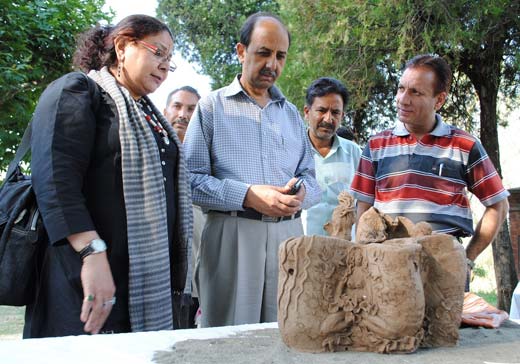Unlike other parts of the world sculpting in Kashmir is associated with economy. It has been a source of livelihood rather than a way of expression for Kashmiris. But a recently concluded Terracotta camp in Srinagar has marked the beginning of change in attitude towards art and artists, Irfan Mehraj reports.

It took a while for people to come to terms with the fact that sculpting and other related forms of art are actually ways of expressing artist’s inner feeling and not just an economic activity.
It was during an eight day Terracotta Camp held at the foothills of picturesque Zabarwan hills that Kashmiris came face to face with this form of art.
Organized by Jammu and Kashmir Academy of Arts, Culture and Languages in association with Dara Shikoh centre for arts New Delhi, the camp was the first of its kind in the Kashmir valley.
Previously sculptors in Kashmir would work in the standard medium of stone and wood, but with holding this camp the Cultural Academy aims to initiate Terracotta style of sculpting in the valley. Terracotta is the potter’s clay commonly used for making earthenware.
A total of eleven sculptors participated in the eight day camp held in the almond villa, Gupkar Road, Srinagar, residence of the daughter of Dr Karan Singh. Out of the eleven artists seven were from Jammu and four belong to the valley.
Mohammad Iqbal Joo, a sculptor from Srinagar who participated in the camp exhibited his work aquarium which is a depiction of a stream flowing through a mountain.
Ruing the fact of meager interest shown by the common public towards art, Iqbal said, “Art’s purpose is to bring people closer to the creator; the originator of beauty. It is unfortunate that art/sculpting here is viewed as a sin when it actually is a direction towards attaining unity with the creator.”
The lack of interest from larger masses towards art in the valley can be attributed to several reasons. One of them is the unavailability of a functioning art gallery. “When art is not showcased and appreciated, it starts to die and with it dies the artist. We are in need of art gallery in the valley where our work can be shown to public and interest in art can be generated,” Iqbal added.
Upon commenting on the lack of general awareness among public towards art, secretary Cultural Academy Khalid Bashir said, “The public interest can be aroused through media. It is highly unfortunate that no major newspaper has a culture specific page, not even a half page for art and culture. Academy can succeed in promoting art and culture with the concerted and collective effort of media.”
Sculptors from Jammu were satisfactorily pleased with the camp with only one or two complaints regarding the clay. Arvind Gupta, a sculptor from Jammu whose sculpture ‘Togetherness’ was an artistic manifestation of two souls united in spirit and body said, “Kashmir is an artist’s delight. This place brings an artist close to the attainment of perfection.” However the artist complained of unseasoned clay due to which one / two sculptures had developed cracks, “the clay for the sculpting needs one to two months of seasoning but we were provided the clay which was seasoned the day before the camp started.”
To this secretary Cultural Academy stated that this was first of its kind camp and we are at the infancy of these things.
Among several thought provoking sculptures made at the camp some of them easily stood out from the rest. Jasleen Singh from Jammu whose work ‘Driftwood in the form of map of JandK’ reflected the irregular terrain of Kashmir’s history. Vikas Khajooria’s depiction of an artist’s reality through a rising building told the story of a bruised and embittered man.
For Gulzar Ahmed Kumar, from Pulwama who provided the clay to the camp the exhibited play holds no value. “There is no use of these works in Kashmiri houses, who would put a Buddha in their homes,” summing up the attitude of common masses towards art.
The camp was concluded by the inspection of the works of art made during eight days by the secretary Cultural Academy who praised the works and individually congratulated the artists.















